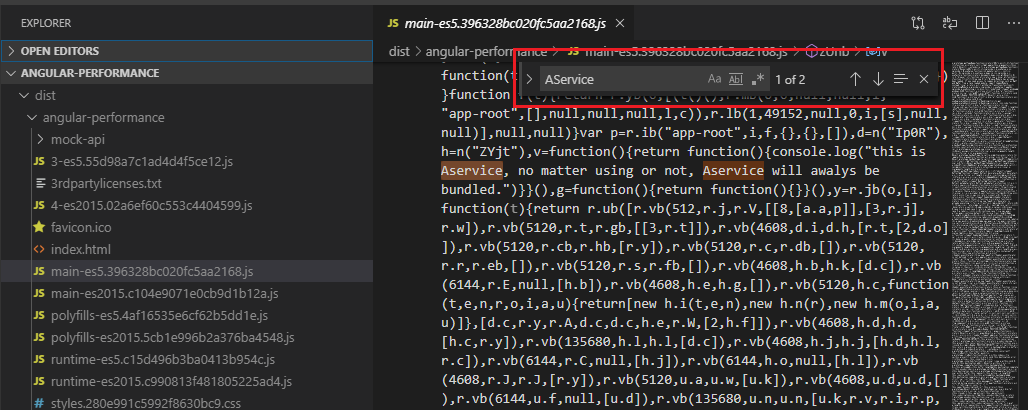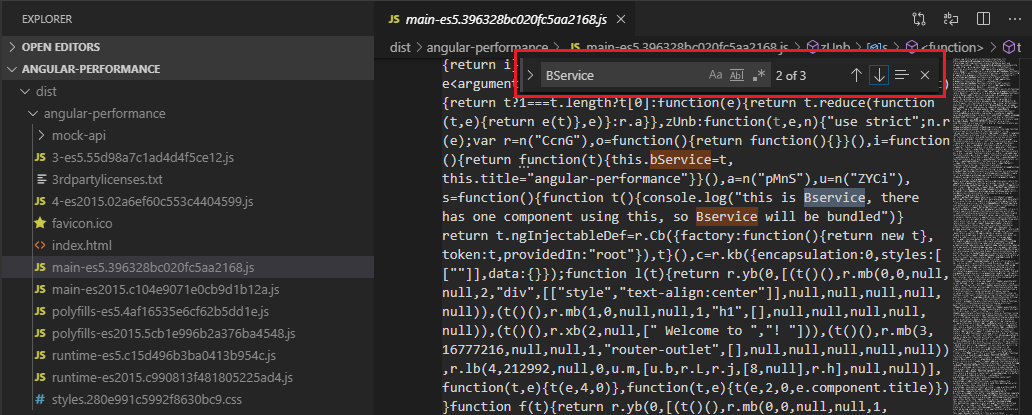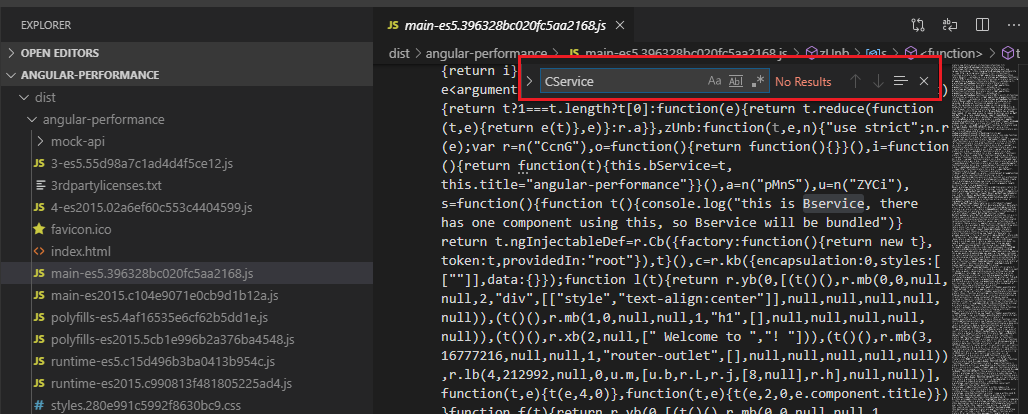在这篇文章中会介绍以下内容:
-
什么是 Tree Shaking,以及它对性能的影响。
-
如何让 Angular(6.0+) 的 Service 实现 Tree Shaking。
-
在 webpack4 的项目中,怎么实现 Tree Shaking。
在文章【Angular:如何在Angular(8.0)中配置Webpack】提到了 Angular 内置的编译打包方式会执行 Tree Shaking,可以提高 Angular 应用的性能。那我们先看下什么是 Tree Shaking。
Tree Shaking
Tree Shaking 是指在编译打包过程中,会把那些定义好的代码但是又没有被调用的代码去掉,不把这些没用到的代码打包到最后的 bundle 文件里,从而可以减小 bundle 文件的体积,提高应用性能。可以把整个应用想象成一棵树,function/component/service/lib 好比是树叶,而那些定义但又没有被调用的 function/component/service/lib 好比是枯树叶,Tree Shaking 就是把那些枯树叶从树上摇下去。
Angular 内置的打包方式在ng build --prod会启用 Tree Shaking,在ng build开发模式下编译不会用 Tree Shaking。我们可以对比 Angular 项目的开发和生产编译结果,来看看 Tree Shaking 的效果,具体代码可以在【angular-performance】查看。
首先定义一个 typescript 的 module,export 两个 function:square,cube;具体代码如下:
// common-utility.ts
export function square(x) {
console.log("this is square function in commonutility");
return x * x;
}
export function cube(x) {
console.log("this is cube function in commonutility");
return x * x * x;
}
然后在 DashboardComponent 中只引用 cube 方法:
//dashboard.module.ts
import { Component, OnInit } from "@angular/core";
import { cube } from "../../shared/common-utility";
@Component({
templateUrl: "./dashboard.component.html"
})
export class DashboardComponent implements OnInit {
ngOnInit() {
console.log("here is the cube result " + cube(3));
}
}
用ng serve把项目跑起来以后,在 console 里会有以下的输出:
this is cube function in commonutility
dashboard.component.ts:12 here is the cube result 27
之前说过在ng build开发模式下编译不会用 Tree Shaking,所以编译以后的 bundle 文件里会有square方法的源码,我们ng build编译代码看下结果:
在编译后的 bunlde 文件:modules-dashboard-dashboard-module-es5.js 里,我们能看到如下代码,没有 Tree Shaking,square(x)方法在整个项目里都没有被调用,但是编译打包的时候,还是把整个方法放进了最后的 bundle 文件里,在 bundle 文件的相关代码如下:
/***/ "./src/app/shared/common-utility.ts":
/*!******************************************!*\
!*** ./src/app/shared/common-utility.ts ***!
\******************************************/
/*! exports provided: square, cube */
/***/ (function(module, __webpack_exports__, __webpack_require__) {
"use strict";
__webpack_require__.r(__webpack_exports__);
/* harmony export (binding) */ __webpack_require__.d(__webpack_exports__, "square", function() { return square; });
/* harmony export (binding) */ __webpack_require__.d(__webpack_exports__, "cube", function() { return cube; });
function square(x) {
console.log("this is square function in commonutility");
return x * x;
}
function cube(x) {
console.log("this is cube function in commonutility");
return x * x * x;
}
/***/ })
我们再来试一下ng build --prod启用 Tree Shaking,因为ng build --prod不仅会做 Tree Shaking 还会做 Minification 和 Uglification,所以最后的编译代码都是被处理过的。不能直观的看代码,但是在square和cube里都有 console log,我们可以通过在最后编译 bundle 文件:3-es5.55d98a7c1ad4d4f5ce12.js 里用关键字‘commonutility’来搜索查看。结果如下:

“this is square function in commonutility”并没有在最后的 bundle 文件里,说明启用 Tree Shaking 之后不会把 square 打包进最后的 bundle 文件里。
如何让 Angular(6.0+) 的 Service 实现 Tree Shaking
Angular6 发布了一项新功能:Tree Shakeable Providers,这个新的功能是用来让 Angular 中的 service 也可以 Tree Shaking。在此之前,Angular 中的 service 都是依赖注入的,service 都是通过 @Injectable 装饰器定义,比如定义一个 AService 如下:
import { Injectable } from "@angular/core";
@Injectable()
export class AService {
constructor() {
console.log("this is Aservice, no matter using or not, Aservice will awalys be bundled.");
}
}
在 component/module 里引用 service 都需要先 import 然后再 providers 元数据里加上对应的 service,比如在 AppModule 引入 AService 的写法如下:
......
import { AService } from "./shared/service/a.service"
@NgModule({
.....
providers: [AService],
bootstrap: [AppComponent]
})
export class AppModule { }
Angular 在编译的时候,因为已经有import { AService }语句,那么不管这个 AService 有没有被调用,对 Angular 来说并不好区分 AService 是否被真正调用,所以不管是否调用,最后 AService 都会被打包进 bundle 文件,没办法做 Tree Shaking。
Angular6.0 发布的新功能:Tree Shakeable Providers,就是用来解决这个问题,通过providedIn元数据选项定义该 service 是用在哪个 module 里,然后在对应的 module 里就不需要显示import { ServiceName },没有 import 语句以后,那么 Angular 在编译的时候就很很容易判断 service 到底有没有被调用,从而可以很容易实现对 service 做 Tree Shaking。我们具体来看看代码示例:
定义一个 BService,providedIn: "root"表示 BService 用在了 root module(AppModule),然后在 AppComponent 调用 BService,代码如下:
//BService
import { Injectable } from "@angular/core";
@Injectable({
providedIn: "root"
})
export class BService {
constructor() {
console.log("this is Bservice, there has one component using this, so Bservice will be bundled");
}
}
//AppComponent
import { Component } from "@angular/core";
import { BService } from "./shared/service/b.service";
@Component({
selector: "app-root",
templateUrl: "./app.component.html",
styleUrls: ["./app.component.css"]
})
export class AppComponent {
title = "angular-performance";
constructor(private bService: BService) { }
}
为了对比,我们在定义一个 CService,providedIn: "root"表示 CService 用在了 root module(AppModule),但是不再任何地方调用 CService,代码如下:
import { Injectable } from "@angular/core";
@Injectable({
providedIn: "root"
})
export class CService {
constructor() {
console.log("this is Cservice, there has no component using this, so Cservice won't be bundled.");
}
}
再用ng build --prod编译打包,service 文件会打包到main-es5.396328bc020fc5aa2168.jsbundle 文件里,同样通过关键字搜索的方式来看下结果:
搜索:AService,可以看到 AService 没有用providedIn: "root",而且没有被调用,有 Tree Shaking,但是因为在 AppModule 有import { AService },不管是否被调用都会打包进最后的 bundle 文件。

搜索:BService,可以看到 BService 用providedIn: "root",在 AppModule 不需要import { BService },并且在 AppComponent 里调用,有 Tree Shaking,会被打包进最后的 bundle 文件。

搜索:CService,可以看到 CService 用providedIn: "root",在 AppModule 不需要import { CService },但是没有被调用,有 Tree Shaking,不会被打包进最后的 bundle 文件。

在 webpack4 的项目中,怎么实现 Tree Shaking
如果不用 Angular 内置的打包方式做 Tree Shaking,那么在 webpack4 怎么实现 Tree Shaking?在 webpack 官方文档:【Webpack Tree Shaking】有介绍结合 "sideEffects": false和 mode: "production"实现 Tree Shaking,我尝试用当前最新的 webpack 版本:webpack@4.39.2搭了一个项目,尝试在 webpack4 中使用 Tree Shaking,发现跟官方文档介绍还是有点出入。
首先用npm init初始化了一个项目,源码在这里:【webpack4-practice】,然后安装 webpack/webpack-cli 等等包。配置好 webpack config 文件。具体如下:
【webpack4-practice/config/webpack.common.config.js】
【webpack4-practice/config/webpack.dev.config.js】
【webpack4-practice/config/webpack.prod.config.js】
在根目录下,创建如下文件:
|----scr
|----index.html
|----main.js
|----shared
|----common-utility.js
common-utility.js 代码如下:
export function square(x) {
console.log("this is square function in commonutility");
return x * x;
}
export function cube(x) {
console.log("this is cube function in commonutility");
return x * x * x;
}
在 main.js 中调用 cube 方法,具体代码如下:
import { cube } from "./shared/common-utility";
console.log("the result for cube(5) is " + cube(5));
此时并没有按官方文档介绍的那样在 package.json 文件中设置"sideEffects": false。只是对 dev 和 prod 的 mode 分别设置 mode:"development" 和 mode:"production"。
运行npm run build:dev,在打包出来的 bundle 文件:main.07bdac8643ee4eaf7a5d.js 中可以看到square方法虽然没有调用,但还是被打包进来了,说明mode:"development"模式下不会 Tree Shaking,
运行npm run build:prod,在打包出来的 bundle 文件:main.a60a09c27b85b5bcc81f.js 中只能看到cube方法被打包,说明mode:"production"模式下,webpack4 默认做 Tree Shaking。
接着按官方文档的介绍,在 package.json 文件中设置 sideEffects:
"name": "webpack4-practice",
"sideEffects": false
或者是:
"name": "webpack4-practice",
"sideEffects": [
"./src/shared/common-utility.js"
]
最后编译的结果跟上面不用 sideEffects 的效果一模一样,说明至少在webpack@4.39.2版本中,只要设置了mode:"production"模式就可以执行 Tree Shaking,跟sideEffects没什么关系。
需要注意的是,Webpack 内置的 Tree Shaking 只对 ES6 module 语法有用,对那些用 Babel 把 ES6 modules 编译成 CommonJS modules 不起作用。